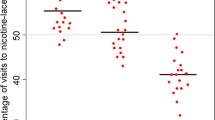Abstract
Bee-pollinated plants are frequently dichogamous: e.g. each flower has a discernable male and female phase, with only the male phase offering a pollen reward. Pollen-collecting bees should therefore discriminate against female-phase flowers to maximise their rate of pollen harvest, but this behaviour would reduce plant fitness due to inferior pollination. Here, we test the hypothesis that flowers use pollen-mimicking floral guides to prevent flower-phase discrimination. Such floral guides resemble pollen in spectral reflection properties and are widespread among angiosperm flowers. In an array of artificial flowers, bumblebees learned less well to discriminate between flower variants simulating different flowering phases when both flower variants carried an additional pollen-yellow guide mark. This effect depended crucially on the pollen-yellow colour of the guide mark and on its spatial position within the artificial flower. We suggest that floral guides evolved to inhibit flower-phase learning in bees by exploiting the innate colour preferences of their pollinators.




Similar content being viewed by others
References
Agren J, Schemske DW (1991) Pollination by deceit in a neotropical monoecious herb, Begonia involucrata. Biotropica 23:235–241, doi:10.2307/2388200
Barrett SCH (1990) The evolution and adaptive significance of heterostyly. Trends Ecol Evol 5:144–148, doi:10.1016/0169-5347(90)90220-8
Barrett SCH (1992) Evolution and function of heterostyly. Springer, Berlin
Barrett SCH (2002) The evolution of plant sexual diversity. Nature Reviews Genetic 3:274–284, doi:10.1038/nrg776
Barrett SCH (2003) Mating strategies in flowering plants: the outcrossing-selfing paradigm and beyond. Philos Trans R Soc Lond B 358:991–1004, doi:10.1098/rstb.2003.1301
Chittka L, Ings TC, Raine NE (2004) Chance and adaptation in the evolution of island bumblebee behaviour. Popul Ecol 46:243–251, doi:10.1007/s10144-004-0180-1
Dafni A, Giurfa M (1999) The functional ecology of floral guides in relation to insects behaviour and vision. In: Wasser SP (ed) Evolutionary theory and processes: modern perspectives. Kluwer, Leiden, pp 363–383
Day TA, Demchik SM (1996) Ultraviolet-B radiation screening effectiveness of reproductive organs in Hesperis matronalis. Environ Exp Bot 36:447–454, doi:0098-8472(95)00048-8
Giurfa M, Eichmann B, Menzel R (1996) Symmetry perception in an insect. Nature 382:458–461, doi:10.1038/382458a0
Goulson D, Cruise JL, Sparrow KR, Harris AJ, Park KJ, Tinsley MC, Gilburn AS (2007) Choosing rewarding flowers; perceptual limitations and innate preferences influence decision making in bumblebees and honeybees. Behav Ecol Sociobiol 61:1523–1529, doi:10.1007/s00265-007-0384-4
Gumbert A (2000) Color choices by bumble bees (Bombus terrestris): innate preferences and generalization after learning. Behav Ecol Sociobiol 48:36–43, doi:10.1007/s002650000213
Heuschen B, Gumbert A, Lunau K (2005) A generalised mimicry system involving angiosperm flower colour, pollen and bumblebees’ innate colour preferences. Plant Syst Evol 252:121–137, doi:10.1007/s00606-004-0249-5
Kelber A (1997) Innate preferences for flower features in the hawkmoth Macroglossum stellatarum. J Exp Biol 200:827–836
Le Corff J, Agren J, Schemske DW (1998) Foral display, pollinator discrimination, and female reproductive success in two monoecious Begonia species. Ecology 79:610–1619, doi:10.2307/176781
Lehrer M, Horridge GA, Zhang SW, Gadagkar R (1995) Shape vision in bees: innate preference for flowerlike patterns. Philos Trans R Soc Lond B 347:123–137
Lunau K (1992) Innate recognition of flowers by bumblebees—orientation of antennae to visual stamen signals. Can J Zool 70:2139–2144, doi:10.1139/z92-288
Lunau K (1995) Notes on the colour of pollen. Plant Syst Evol 198:235–252, doi:10.1007/BF00984739
Lunau K (2000) The ecology and evolution of visual pollen signals. Plant Syst Evol 222:89–111, doi:10.1007/BF00984097
Lunau K (2006) Stamens and mimic stamens as components of floral colour patterns. Bot Jb Syst 127:13–41
Lunau K, Maier EJ (1995) Innate colour preferences of flower visitors. J Comp Physiol A 177:1–19
Lunau K, Wacht S, Chittka L (1996) Colour choices of naive bumble bees and their implications for colour perception. J Comp Physiol A 178:477–489, doi:10.1007/BF00190178
Lunau K, Fieselmann G, Heuschen B, van de Loo A (2006) Visual targeting of components of floral colour patterns in flower-naive bumblebees (Bombus terrestris; Apidae). Naturwissenschaften 93:325–328, doi:10.1007/s00114-006-0105-2
Pacini E, Hesse M (2005) Pollenkitt—its composition, forms and functions. Flora 200:399–415, doi:10.1016/j.flora.2005.02.006
Pohl M, Lunau K (2007) Modification of the innate antennal reaction at floral guides in experienced bumblebees, Bombus terrestris (Hymenoptera: Apidae). Entomol Gener 29:111–123
Thompson WR, Aneshans D, Meinwald J, Eisner T (1972) Flavonols—pigments reponsible for ultraviolet absorption in nectar guide of flower. Science 177:528–530, doi:10.1126/science.177.4048.528
Weiss MR (1997) Innate colour preferences and flexible colour learning in the pipevine swallowtail. Anim Behav 53:1043–1052, doi:10.1006/anbe.1996.0357
Witjes S, Eltz T (2007) Influence of scent deposits on flower choice: experiments in an artificial flower array with bumblebees. Apidologie 38:12–18, doi:10.1051/apido:2006048
Wolfe LM, Barrett SCH (1987) Pollinator foraging behavior and pollen collection on the floral morphs of tristylous Pontederia cordata L.. Oecologia 74:347–351, doi:10.1007/BF00378928
Acknowledgements
We thank T. Eltz (Düsseldorf) for helping to improve an earlier version of the manuscript, G. Osche (Freiburg) for discussions and A. Thorson for linguistic improvement of the manuscript. This study complies with the German and European Union legislation on animal experimentation.
Author information
Authors and Affiliations
Corresponding author
Additional information
Communicated by R. Moritz
Rights and permissions
About this article
Cite this article
Pohl, M., Watolla, T. & Lunau, K. Anther-mimicking floral guides exploit a conflict between innate preference and learning in bumblebees (Bombus terrestris). Behav Ecol Sociobiol 63, 295–302 (2008). https://doi.org/10.1007/s00265-008-0661-x
Received:
Revised:
Accepted:
Published:
Issue Date:
DOI: https://doi.org/10.1007/s00265-008-0661-x




